His body was broken but not his will
June 16, 2010
When Tom Tindall thinks about life and death these days, he knows the distinction can sometimes be measured in inches and seconds.
“A lot of times people come close to death,” says Tindall, one of Los Angeles County’s top officials. “A lot of times, the truck just misses them and they go on with their lives. The truck didn’t miss me.”
In early April, while Tindall and his wife were touring Nepal on a motorcycle, he was struck from behind by an out-of-control truck that launched him into a concrete wall. He suffered three fractured vertebrae in his neck, broken collar bones on both sides, a cracked sternum, a broken left scapula, a separated shoulder, eight broken ribs and two punctured lungs, one of which collapsed completely. The other functioned barely enough to keep him alive.
“Breath,” he says, “was my struggle.”
Remarkably, just 11 weeks later, Tindall has now begun to return to his job as director of the Internal Services Department, whose 2,000 employees are responsible for everything from information technology services to the maintenance of county buildings. Tindall was named ISD’s director in 2008, after more than a decade of work with the county.
“I refuse to believe that I cannot come back 100% from this thing,” says the lanky 60-year-old, an avid runner and hiker. “Two weeks after the accident, after trying to walk, I thought to myself that I’m going to be in a wheel chair for the rest of my life. But then I told myself, ‘No!’ This is something I need to keep working on and be positive about. It crossed my mind to go on disability but then I wouldn’t be where I am now—getting better.”
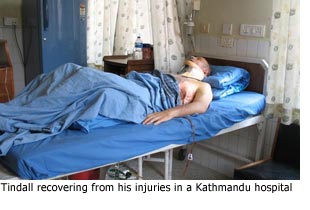 Looking at Tindall these days, you’d be hard pressed to see any evidence of the trauma that nearly killed him. The only outward sign is that he now tilts slightly to the left, the result of a fractured shoulder blade that will require extensive physical therapy. But without a shirt, he says, it’s not so pretty. “I look like Frankenstein,” he says, because of scars and indentations from broken bones.
Looking at Tindall these days, you’d be hard pressed to see any evidence of the trauma that nearly killed him. The only outward sign is that he now tilts slightly to the left, the result of a fractured shoulder blade that will require extensive physical therapy. But without a shirt, he says, it’s not so pretty. “I look like Frankenstein,” he says, because of scars and indentations from broken bones.
Tindall’s recovery is all the more remarkable because of the accident’s location—far from the world of sophisticated Western medicine—in the village of Itahari in southeast Nepal.
Tindall and his wife, Okyo, arrived there late in the afternoon on April 4, Easter Sunday, the fourth day of a journey that began in the Nepalese capitol of Kathmandu. This was Tindall’s third trip to Nepal, his first as part of a small group touring on motorcycles.
When they rolled into Itahari at around 4:30 p.m., Tindall says his wife, who was riding on the back of his motorcycle, developed a cramp. Tindall suggested she take a seat in the pace car that had been driving behind them with extra gasoline—a move that potentially saved her from the kind of physical wreckage that was about to claim her husband.
As the group began slowly making its way through town, a truck apparently failed to recognize that traffic had slowed and plowed into Tindall.
“Next thing I know,” Tindall says, “I woke up in a police vehicle transporting me to a clinic.”
Thirty miles later, they arrived at that clinic only to learn that the X-ray machine was broken. The next day, a helicopter transported him back to Kathmandu. On the advice of a locally-based American doctor, he was admitted to B & B Hospital, where, among many other things, his vertebrae were fused and wired together. He remained in Nepal for a month, until his lungs had improved enough for him to be flown back to the U.S. During that time, he says, L.A. County Chief Executive Officer William T Fujioka often checked in with him.
In recent days, Tindall, a former Army paratrooper, says he’s begun getting back in shape, walking two miles in the evening as well as going to physical therapy several times a week. He’s now in the office on many days, meeting with Internal Services staffers and getting the department ready for one of its newest jobs—administering a program to help homeowners finance solar energy installations through a special loan program.
On a deeper level, Tindall says, he’s still reflecting on how he’s been changed by his near-death experience in the land of Mt. Everest.
He says that, in his darkest hours, he prayed for help when he was struggling to breathe, despite the religious doubts he’s harbored throughout the years. But to his surprise, he says, “I found comfort, and it moved me closer to some kind of sense that you can give yourself over to the unknown…I don’t know how you can go through something like this without a renewed view of your life and its connections to something bigger.”
Posted 6/16/10
A graduation full of inspiration
June 7, 2010
Maria Burgos is on her way to the Ivy League. Five years ago, she was selling gum on the streets of Tijuana.
Maria was only 13 at the time, but she knew this was no life for her—mired in poverty, working long hours alongside a father who’d been deported to Mexico after a string of arrests in L.A. By then, she’d already been removed from her parents and returned to them several times, starting after her first birthday.
Begging and pleading, Maria convinced her parents to let her cross the border to stay with a family friend in Los Angeles, where she was born as a legal resident and wanted to attend school again. “I knew I couldn’t control all aspects of my life,” she recalls, “but I knew I could control my education. I just went for the A’s.”
So began a rocky journey that would land Maria in six foster homes by her freshman year, when she finally found stability and success in the care of a middle school counselor and her husband. This year, Maria graduated from Pioneer High School in Whittier with a 4.02 grade point average and has been accepted to Brown University in Rhode Island. The 18-year-old says she wants be a pediatrician.
“I never felt sorry for myself,” says Maria, who was captain of the varsity cross country team and has run four L.A. Marathons. “Being in foster care was so much better than being with my parents. I didn’t see it as an obstacle. I saw it as an opportunity.”
On Tuesday night, Maria and more than a hundred other foster youth will be honored for their academic achievements and awarded thousands of dollars in scholarships during a gala at Walt Disney Concert Hall. The event, “Celebration 2010,” is now in its 21st year and is largely organized by L.A. County’s Department of Children and Family Services and United Friends of the Children, a private group that helps foster youth successfully transition into adulthood. The evening’s host will be comedian Paul Rodriguez, with actress Jada Pinkett Smith as the keynote speaker.
“Insane challenges”
The young honorees are among the most extraordinary of graduates in this season of high school commencements. Still in their teens, they’ve suffered years of abuse and abandonment. They’ve bounced from one school to the next, creating gaps in their education. Too often, they’ve been told by grown-ups at home and in the classroom that they’ll never amount to much.
“They have this amazing resilience,” says Monica Bomkamp Enia, education program director for United Friends of the Children. “They go through these insane challenges and still come out on top.”
Frequently, she says, the successful students have someone in their lives—a teacher, a grandparent, a coach, a social worker—who has told them: “You can do this and I’m going to help you.” Sometimes, she says, they’re driven by nothing more than a powerful determination to prove people wrong.
“Our take,” Enia says, “is that there is no reason people should expect less from them.” She says her organization, founded by the late Nancy M. Daly, is dedicated to becoming the positive voice in the lives of foster children—and backing it up with logistical and financial support.
Forty students participating in Tuesday’s event will receive UFC scholarships of $15,000 spread across five years, along with help picking colleges and finding other funding sources. The others also will receive grants of various sizes from a variety of organizations. Of those who’ve previously participated in UFC’s college sponsorship program, more than 70% have graduated—an off-the-charts rate for foster youth.
Each student who’ll proudly stride across Disney Hall’s stunning stage has traveled a uniquely tortuous route to get there. But they all share this: a fierce determination, rooted in their difficult journeys, to build promising futures for themselves.
“Itching to go”
 Cynthia Lapos found her voice at Canyon High School.
Cynthia Lapos found her voice at Canyon High School.
As a member of the debate and speech team, she became one of California’s top competitors in oratorical interpretation—taking an existing speech and recreating the effect intended by the author.
“I can say things in a speech and the audience will believe me,” she says. “They’re not seeing me as someone who was abused for nine years. They’re viewing me as someone who is doing a great job.”
For years, Cynthia kept silent about her father’s alleged abuse. “I didn’t want the family to crumble and fall away,” she says. But her secret was revealed when her stepmother discovered a detailed letter Cynthia had written about her treatment and had stashed away, thinking she might someday be brave enough to give it to someone.
With no direct evidence against Cynthia’s father, who denied the abuse allegations, no charges were filed. Still, the discovery of the letter led to Cynthia’s placement at age 16 in a Canyon Country foster home with her best friend, a former foster youth who’d been adopted by the family.
“We kept our foster license open but we weren’t intending to have another child,” says Sheri Flay, who, with her partner Victoria Bennett, has been caring for Cynthia for two years. “It was just the right thing at the right time.”
In the aftermath of all this upheaval, Cynthia says “she fell into the deepest state of depression…I put all the blame on myself when I was the victim.” She worried that she was “tainted” and that people “wouldn’t want to be with me.” Nonetheless, she says, “I wouldn’t let myself drop below a 3.0.”
And she didn’t.
Cynthia, who turns 18 on Thursday, graduated from Canyon High School with a 3.31 grade point average. In the fall, she’ll be off to California State University at Northridge, where she’ll live on campus. “I’m itching to go,” she says. “College has been my dream.”
In an essay Cynthia wrote as part of the application process for Tuesday’s event, she put any doubters on notice: “I am someone who will not back down. I will not give up.”
“Bragging rights”
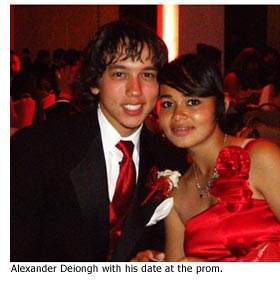 Since the age of 10, Alexander Deiongh has lived in foster homes stretching from Fontana to Long Beach, seven in all. He says his birth mother was “great” to him and his brother, except when she didn’t take her medication for a bi-polar condition, which was often. “When she’s not on her medication,” he says, “she’s not worried about us.”
Since the age of 10, Alexander Deiongh has lived in foster homes stretching from Fontana to Long Beach, seven in all. He says his birth mother was “great” to him and his brother, except when she didn’t take her medication for a bi-polar condition, which was often. “When she’s not on her medication,” he says, “she’s not worried about us.”
Alexander remembers many times when police and social workers removed him and his brother from their Highland Park home after their mom vanished, leaving them to fend for themselves. Eventually, the court would reunite the family, but each time the story was the same.
The last time Alexander lived with his mother was in his sophomore year at Franklin High School. He and his brother were determined to keep her on track. “We thought we could ride it out and help her with her medication,” he says. But once again, she disappeared, this time to Las Vegas.
“We didn’t tell anyone because we didn’t want to be taken away again,” he says.
But someone did alert authorities and the boys were removed for the final time. They eventually were placed in separate homes after Alexander repeatedly complained that his brother was physically abusive. Since November, 2007, Alexander has lived in North Hollywood with a couple he says have provided him with the financial and emotional support he needed to excel.
“I’d like to say it’s all me,” the 18-year-old football player says of his success. “But it’s also the foster parents who guide you.”
In two weeks, Alexander will graduate from North Hollywood High School with a 3.65 grade point average. In the fall, he’ll be attending UCLA, focusing on math and the sciences.
He admits to being motivated by “bragging rights” because of the rough treatment he received from his brother, who was always critical of him and has not fared nearly so well. If Alexander saw him today, he says, he’d tell him off: “You criticized me the whole time and look at me and look at you!”
But that’s far from the whole of it.
“I knew that I didn’t want to spend my whole life on minimum wage jobs,” he said the other day after being fitted for a prom tuxedo. “I did not want to live up to a stereotype of what a foster kid is.”
Posted 6/07/10
Merce Cunningham troupe dances before saying goodbye
May 13, 2010
 Merce Cunningham was internationally recognized as one of the greatest choreographers who ever lived, an artistic force in the dance world for more than seven decades. His passing last year at the age of 90 left a void that won’t easily be filled, particularly since the troupe he founded, the Merce Cunningham Dance Company, has announced that after embarking on a two-year Legacy Tour in their founder’s honor, they will officially disband.
Merce Cunningham was internationally recognized as one of the greatest choreographers who ever lived, an artistic force in the dance world for more than seven decades. His passing last year at the age of 90 left a void that won’t easily be filled, particularly since the troupe he founded, the Merce Cunningham Dance Company, has announced that after embarking on a two-year Legacy Tour in their founder’s honor, they will officially disband.
But as dance aficionados are mourning his loss, they will also be celebrating his achievements when the Music Center presents on the Walt Disney Concert Hall stage the world premiere of the reconstructed piece ROARATORIO, specially commissioned by the Music Center, Festival Montpellier Danse 2010, and Théâtre de la Ville/Festival d’Automne à Paris. Accompanying the three performances will be the music of modernist composer John Cage. Also taking place will be a number of related events, including discussions, lectures, art exhibits and interactive workshops.
Single tickets are still available for the June 2-4 performances at Walt Disney Concert Hall; for an appreciation of Cunningham’s artistic contributions, check out local visual and performing arts blog artsmeme.
Posted 5-13-10
Hollywood Bowl Rolls Out 2010 Summer Season
April 23, 2010
If it’s summer, it’s the Hollywood Bowl.
This year’s amazing lineup kicks off June 18 with an Opening Night Gala to benefit Music Matters, the LA Philharmonic’s fund for musical education. That evening, the 2010 Hollywood Bowl Hall of Fame inductees will be disco queen Donna Summer, The Carpenters and classical pianist Jean-Yves Thibaudet. Hosting the evening will be legendary musician/composer/producer Herb Alpert.
Like every summer, the Bowl will bring you some of the biggest names in music, including Sting, Herbie Hancock, Smokey Robinson, John Mayer, The Dave Matthews Band, Harry Connick Jr., Lee Ritenour and Dave Grusin—and, of course, the Philharmonic’s own superstar, Gustavo Dudamel, who, among other things, will conduct the opera Carmen.
Other highlights of the summer season include the traditional July 4th Fireworks Spectacular with Vince Gill, the return of Wednesday night “Jazz at the Bowl” and Sunday Sunset Concerts, which will feature a special Beatles Celebration marking the 45th anniversary of the Fabs’ visit to the Hollywood Bowl.
Here’s the Hollywood Bowl ticket page. See you there!
Posted 4/23/10
Leading the charge from Malibu to Port au Prince
January 22, 2010
Battalion Chief Terry DeJournett commands the largest fire battalion in the Los Angeles County Fire Department, with 12 fire stations that cover the Santa Monica Mountains.
So what’s he doing in Haiti?
DeJournett, 55, is running the 72-person L.A. County urban search and rescue team that was rushed to Haiti last week in the wake of an earthquake that has left the nation in ruins. Already, the team has saved nine victims from the rubble, including three women buried under a collapsed Port-au-Prince apartment building and another who was pulled from the remains of a bank.
“The thing you get with Terry is defined leadership,” says Battalion Chief Thomas Ewald, who is directing from Pacoima the support of the Haiti mission. Ewald says DeJournett thrives as a tactical commander in the field.
The task force’s work has drawn international acclaim and attention, including a CNN interview (see below) Wednesday during which DeJournett praised the Haitian’s resiliency. “The fact that we are still making rescues,” he said, “shows the strength of the people here.”
Cathy DeJournett, his wife of 34 years, has taken comfort hearing her husband’s voice a few times during conference calls arranged by the department each night. “He’s enjoying being able to help people there so much,” she said. The family has two grown children.
The stress of having a firefighter spouse who travels to danger spots, Cathy said, “is something you get used to.” She said she draws confidence from the fact that “I know they are doing everything they can to take precautions.”
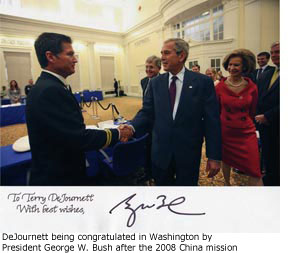 A 24-year County fire veteran, DeJournett joined the elite squad in 1991 and rotates the front-line leadership with a half dozen colleagues. He has traveled throughout the world. Less than two years ago, for example, he led a small rescue contingent to China following the Sichuan earthquake. On his return, he flew to Washington to receive congratulations from then-President George W. Bush. He also frequently travels abroad representing L.A. County and the U.S. in training missions in Asia, Europe, Africa and Australia.
A 24-year County fire veteran, DeJournett joined the elite squad in 1991 and rotates the front-line leadership with a half dozen colleagues. He has traveled throughout the world. Less than two years ago, for example, he led a small rescue contingent to China following the Sichuan earthquake. On his return, he flew to Washington to receive congratulations from then-President George W. Bush. He also frequently travels abroad representing L.A. County and the U.S. in training missions in Asia, Europe, Africa and Australia.
Closer to home, DeJournett , who performed rescue work during the 1994 Northridge earthquake and the 1995 Oklahoma City bombing, leads firefighting teams in the hills above L.A. He directed the assault on a portion of the Station Fire last summer, as well as during the Malibu fire in 2007. Since 2006, he’s been the Battalion 5 chief, overseeing stations stretching from Westlake Village and Malibu to Topanga and Calabasas.
“He runs a tight ship,” said his boss, Assistant Chief Gary Burden. “When he is on the scene, he gets a lot of respect because of his experience.”
How long DeJournett’s team will stay in Haiti remains unclear.
—————————————————————————————————————————————–
READ RELATED HAITI NEWS
Investigating child deaths–and the system
October 19, 2009
Rose Belda hit the ground floor running.
Working from a basement office in the Hall of Administration, the newly hired chief of the Children’s Special Investigations Unit already had been directed by the Board of Supervisors to examine the deaths of 36 children. With no staff yet, she was doing her own photocopying of case files.
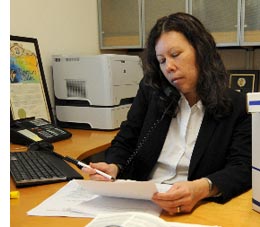 Belda nodded towards a six-inch stack of confidential files she’d just run off about Lazhanae S., a 13-year-old charge of the Department of Children and Family Services who, in March, was stabbed to death in South L.A. after bolting from a DCFS-monitored foster home. “Here’s my reading for tonight,” Belda said.
Belda nodded towards a six-inch stack of confidential files she’d just run off about Lazhanae S., a 13-year-old charge of the Department of Children and Family Services who, in March, was stabbed to death in South L.A. after bolting from a DCFS-monitored foster home. “Here’s my reading for tonight,” Belda said.
Her workload won’t lighten anytime soon.
The board hired Belda in September as the unit’s lead attorney to investigate deaths and other “critical incidents” of abuse or neglect of children known to have had contact with the Department of Children and Family Services. She’ll advise the supervisors about needed improvements, offering advice about what works and what doesn’t.
Belda will also examine issues of accountability within children’s services, including whether appropriate disciplinary action was taken, as well as whether problems exist within the overlapping responsibilities of various county departments, including DCFS, probation, mental health and health services.
“Some of the system issues that need to be fixed are huge,” she says of her mandate. “They are not going to be fixed by small changes in policy – by adding a word here or there. I wish it were that easy.”
No doubt, Belda’s own work will be under the microscope, too. She begins her job after several high-profile deaths—and numerous critical news stories—have raised troubling questions about county services to kids in trouble.
In July, Dae’von B., 6, was found beaten to death after the boy had complained of abuse to teachers, health care staffers and social workers. His mother’s ex-boyfriend has been charged in the case. In that same month, preschooler Lars S. of Highland Park was decapitated by his mother, who killed herself, just months after county investigators looking into the mom’s mental health declined to remove the boy from her care. And two months later, In August, 19-month-old Jasmine G. died under mysterious circumstances while in county-supervised foster care.
Belda, 49, believes her experience as County Counsel’s legal advisor to DCFS since 2001 will give her an edge in investigating such tragedies. “Being an insider, I’m not coming in cold,” says Belda.
Belda says that, during her early years with the county representing the interests of children in dependency court, she saw up close the harm that can come to youngsters caught up in the system.
“I have a strong recall of a lot the cases that came in when the kids were really hurt,” says Belda. “In other [county] departments, when someone is asleep at the wheel, people don’t die. This is an area where the impact is so immediate and so quick and so swift. The kids can really get hurt…They need good people to step up for them.”
The mother of two teens, Belda lives in Hollywood with her husband, Superior Court Judge Victor Greenberg, who once held a similar post in the 1990s investigating child deaths as an inspector general in the Auditor Controller’s office.
The new post, which pays $193,000 annually, reports directly to the board.
DCFS Director Trish Ploehn called Belda an “excellent selection” and says she doesn’t believe Belda’s direct line to the supervisors will make adversaries out of her investigative unit and DCFS. “Hopefully,” Ploehn says, “the aim of my department, the board and the CSIU are all the same—find out what has gone wrong in tragic cases and find ways to fix the problems.”
Belda, asked whether she’s experienced any obstacles in her investigations so far, made a politic bow toward the cooperation she’s getting from DCFS and other departments.
“I haven’t found any big impediments,” she says. “All of the county departments have been helpful even when they know that I’m sort of targeting them. People have been, if not thrilled, super polite and super responsive. That’s a real positive.”
The wreckage beyond the crash
September 1, 2008
It’s been more than a week since the Metrolink crash and I’m still haunted by Beckie Pompel.
I met her at Chatsworth High School well past midnight on that horrible Friday night, September 12. She was among more than 100 people who’d gathered there in gut-wrenching uncertainty, awaiting word on the fate of loved ones whose names were missing from lists of the injured. There was despondency, and there were tears.
I’d arrived at the school after spending hours at the scene of the head-on collision. There, amid the overpowering smell of diesel fuel, I witnessed first-hand the heroic response of an army of firefighters and law enforcement officers as they clawed through the tangled debris, where 25 Metrolink commuters perished.
At one point, when the flag-draped body of uniformed LAPD officer Spree Desha was lifted from the train, I watched the firefighters halt their grim work. With helmets off, they sat motionless atop the Metrolink’s toppled first passenger car, as though the magnitude of what they’d been doing since early evening had finally sunk in.
For me, I could think only of how that single tragedy was being multiplied across two dozen other families, of the fragile and fleeting nature of life—thoughts that would become even more overpowering in the hours ahead at Chatsworth High.
When Sheriff Lee Baca first asked me to accompany him to the school, I was reluctant. I didn’t want to deal with the immense grief I knew would be awaiting us. However, I also thought that perhaps I could provide a measure of comfort, that maybe I could hold someone’s hand or put an arm around a shoulder. So, despite my anxiety, I went.
Over the years, I’ve seen too many fatal disasters—plane crashes, fires, floods, earthquakes, even the last Metrolink crash in Glendale. Yet none of them, not even this accident, had the emotional impact of what I’d encounter at Chatsworth High, with scores of distraught people praying for the best but fearing for the worst. Many had been waiting for news about their families and friends for eight hours. They were increasingly anxious, despite the best efforts of our fine County mental health specialists and the L.A. city volunteers who’d been dispatched to the school.
Beckie Pompel seemed to be an exception.
When I arrived, the 63-year-old wife of Metrolink passenger Howard Pompel recognized me and immediately introduced herself. She was kind and open, and she instantly put me at ease. As we shook hands, she told me she was reasonably optimistic that her husband had survived the crash, even though there was no record of him being transported to a hospital. He always rode in the last car, the safest one. He’ll turn up, she said.
My heart sank. I couldn’t be as upbeat. A few hours earlier, I’d been told by fire officials that two commuters, whom they did not identify, had in fact died in that final car. I gamely encouraged her to keep praying but, in my gut, I had a sinking feeling that she was never going to see her husband again.
That night, after getting home in the wee hours, I couldn’t sleep. I kept thinking about all those shattered lives and about Beckie Pompel. I felt a bond with her. And, like her, I wanted to believe.
Sometime after 4:00 a.m., the names of the fatalities began to trickle in. When I first saw the list, I quickly searched for Howard Pompel, hoping beyond hope his name wasn’t there. But it was. The discovery sucked the air out of me. I knew that the smiling, optimistic face I’d seen only hours earlier was now gone, replaced by grief and anguish over the loss of a 69-year-old husband, the father of three, a grandfather of five.
I know that the public is often cynical about why politicians dash to the scenes of calamitous events, as I did on that tragic Friday night. The rap is that we’re just looking for publicity and visibility. In some cases, that cynicism is justified.
I can only speak for myself: Throughout my political life, I’ve made it a practice to get out of the comfort zone of my Civic Center office and into the communities I serve. In my experience, this is the only way to get unfettered and unfiltered information on the performance of our government agencies. What’s more, County workers on the front-lines have told me that they appreciate the show of support. We are, after all, on the same team.
Maybe more important, in times of tragedy I have the chance to see and feel the real-life struggles that people confront, to develop a level of empathy that can’t be achieved by reading the statistical reports and charts that move across my desk.
To me, this deeper understanding of the kind of pain suffered by Beckie Pompel and so many others like her is essential to my service as an elected official. Sure, we’ll learn from this tragedy. We’ll plug the safety gaps that were exposed in this accident. Rules will change, new regulations will be imposed and investments in new technology will be made. The sooner the better.
But more than anything else, I’m motivated by an unconditional commitment to never having to look another Beckie Pompel in the eye.




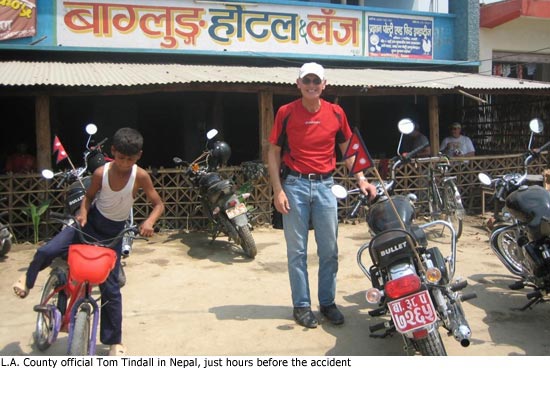
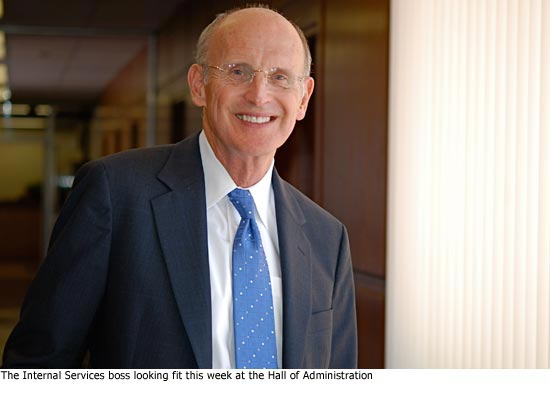


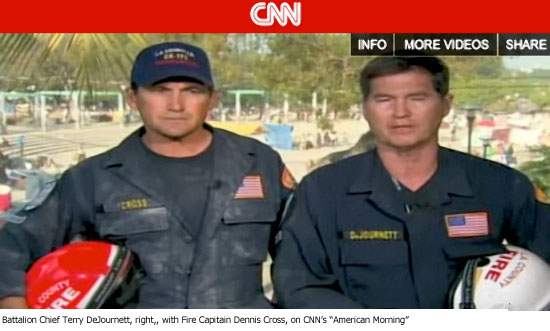
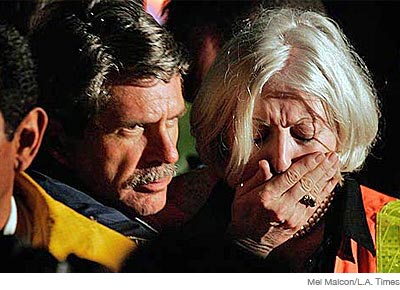







 405 bridge work causes a stink
405 bridge work causes a stink

